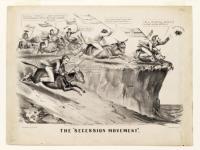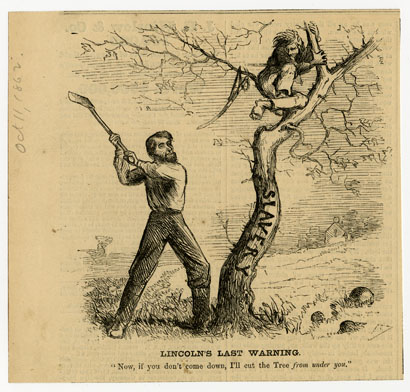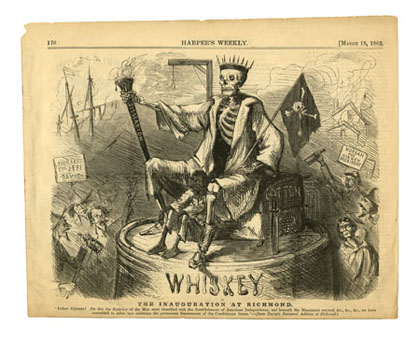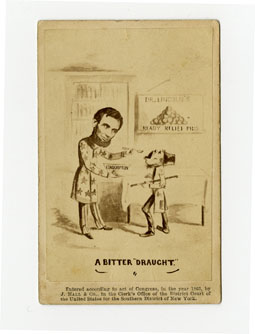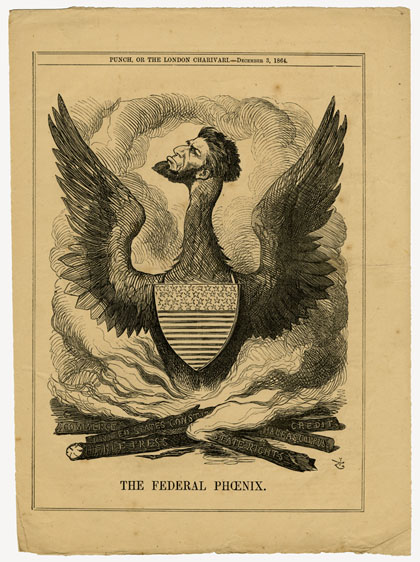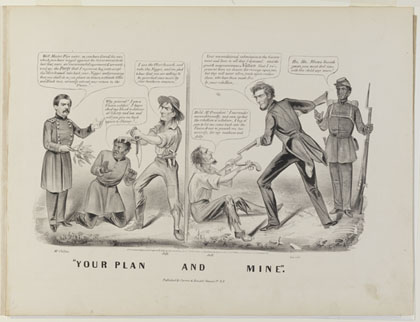We may have wrapped up the William Still Digital History Project (for now), but we’re still up to our elbows in digital history work here at HSP.
Our Historic Images, New Technologies (HINT) project is developing new tools for managing and describing graphics materials. You can read more details about the project here, and keep an eye out for more blog posts about our progress in the coming weeks and months.
But forget about the "technology" part for a minute. Let's talk about what we'll be using to demonstrate that technology: political cartoons!
These cartoons are complicated graphic items, challenging viewers to decode meaning not only from the cartoon's caption or dialog text, but also through its imagery, symbolism and allegory.
Sometimes, the general gist of an old cartoon is still fairly clear to modern viewers, as with this commentary on Abraham Lincoln and slavery:
"Lincoln's Last Warning," from Harper's Weekly, October 11, 1862. (HSP Cartoons and Caricatures collection, #3133).
Other cartoons are more obscure, referencing events and people that modern viewers don't recognize.
For the next year or so, we'll be working on a new digital history exhibit that will help to illuminate some of these obscurities.
We'll be selecting approximately 500 political cartoons from HSP's collections to help show off the new technology we're developing in the HINT project, and we'll be creating additional contextual materials to help users better understand the cartoons and help educators incorporate them into the classroom.
We certainly have plenty of cartoons to choose from at HSP. To date, project staff have identified 1600+ political cartoons in just six collections: the Historical Society of Pennsylvania cartoons and caricatures collection (#3133), the Balch Broadsides: Satirical Cartoons collection (#PG278), the Hampton L. Carson papers (#117); HSP small graphics collection (#V63); HSP medium graphics collection (#V64); and HSP large graphics collection (#V65). We estimate that the scrapbooks of Pennsylvania Cartoons 1902-1915 (call # Vb# .9199F) contain another roughly 1700 cartoons.
We plan to organize the cartoon digital exhibit into six chronological sections that span the mid-eighteenth-century to 1923, and my colleague Rachel Moloshok and I are currently finalizing our selections for each section.
Here are a few of the 500 or so Civil War era cartoons that we plan to include in the digital history exhibit:
"The Inauguration at Richmond," from Harper's Weekly, March 15, 1862. (HSP Cartoons and Caricatures collection, #3133).
"A Bitter 'Draught,'" 1863. (HSP Cartoons and Caricatures collection, #3133)
"The Federal Phoenix," from Punch, December 3, 1864. (HSP Cartoons and Caricatures collection, #3133).
"Your Plan and Mine," 1864. (HSP Cartoons and Caricatures collection, #3133).

